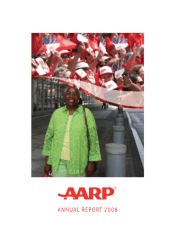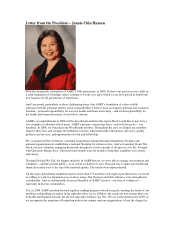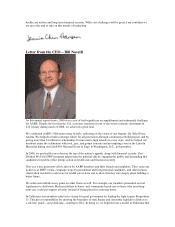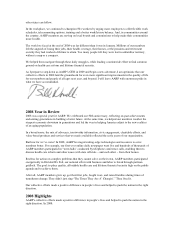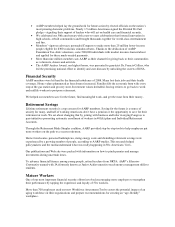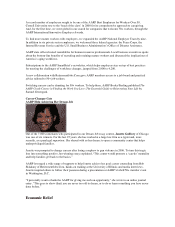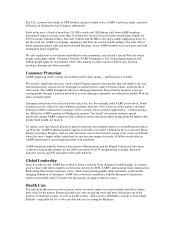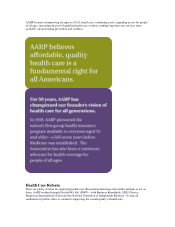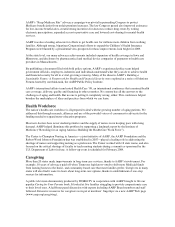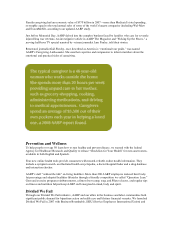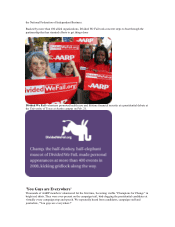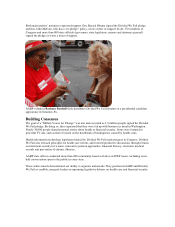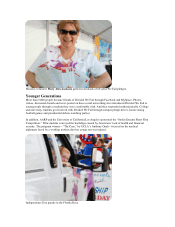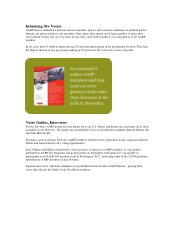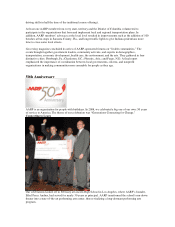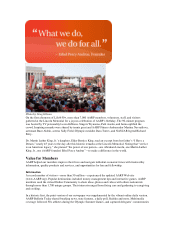AARP 2008 Annual Report Download - page 9
Download and view the complete annual report
Please find page 9 of the 2008 AARP annual report below. You can navigate through the pages in the report by either clicking on the pages listed below, or by using the keyword search tool below to find specific information within the annual report.AARP’s “Keep Medicare Fair” advocacy campaign was pivotal in persuading Congress to protect
Medicare beneficiaries from unfair premium increases. The law Congress passed also improved assistance
for low-income beneficiaries, created strong incentives for doctors to reduce drug errors by writing
electronic prescriptions, expanded access to preventive care and lowered cost-sharing for mental-health
services.
AARP was also a leading advocate for efforts to get health care for millions more children from working
families. Although strong, bipartisan Congressional efforts to expand the Children’s Health Insurance
Program were blunted by a presidential veto, prospects for those improvements look bright for 2009.
At the state level, our many advocacy achievements included expansion of health coverage in Iowa and
Minnesota, and disclosure by pharmaceutical and medical device companies of payments to health care
providers in Massachusetts.
By publishing a document filled with bold policy options, AARP’s experienced policy team helped
government officials, employers, industries and individuals understand what they can do to achieve health
and financial security for all in a vital, growing economy. Many of the ideas in AARP’s Building a
Sustainable Future: A Framework for Health and Financial Security were explored at a series of Solutions
Forums hosted by our think-tank, the AARP Public Policy Institute.
AARP’s international affairs team hosted Health Care ’08, an international conference that examined health
care coverage, delivery, quality and financing in other countries. No country has all the answers to the
challenges of aging and health. But no one is getting it completely wrong, either. This conference helped
broaden the marketplace of ideas and practices from which we can learn.
Health Workforce
The nation’s health care workforce is ill-prepared to deal with the growing number of aging patients. We
addressed this through research, alliances and use of the powerful voices of consumers to advocate for the
funding needed to expand nurse-education programs.
Most new doctors have never studied geriatrics and the supply of nurses is not keeping pace with rising
demand. AARP helped illuminate this problem by supporting a landmark report by the Institute of
Medicine (“Retooling for an Aging America: Building the Health Care Work Force”).
The Center to Champion Nursing in America—a joint initiative of AARP, the AARP Foundation and the
Robert Wood Johnson Foundation that was established in 2007—played a leading role in addressing the
shortage of nurses and supporting nursing as a profession. The Center worked with 18 state teams, and also
focused on the critical shortage of faculty to teach nursing students during a summit co-sponsored by the
U.S. Department of Labor in June. A follow-up event is scheduled for February 2009.
Caregiving
More than 20 states made improvements in long-term care services, thanks to AARP’s involvement. For
example, 10 years of advocacy paid off when Tennessee legislators voted to shift more Medicaid funds
from nursing homes to the home- and community-based care that most families prefer. Caregivers in many
states will also find it easier to learn about long-term care options, thanks to establishment of one-stop
sources for information.
A public television documentary produced by WGBH-TV in cooperation with AARP brought to life our
popular Caring for Your Parents book. It looked at five families struggling to provide compassionate care
to their loved ones. A half-hour panel discussion with experts including AARP Board members and staff
followed. Extensive resources for caregivers were put at members’ fingertips via a new AARP Web page
(www.aarp.org/caregiving).

